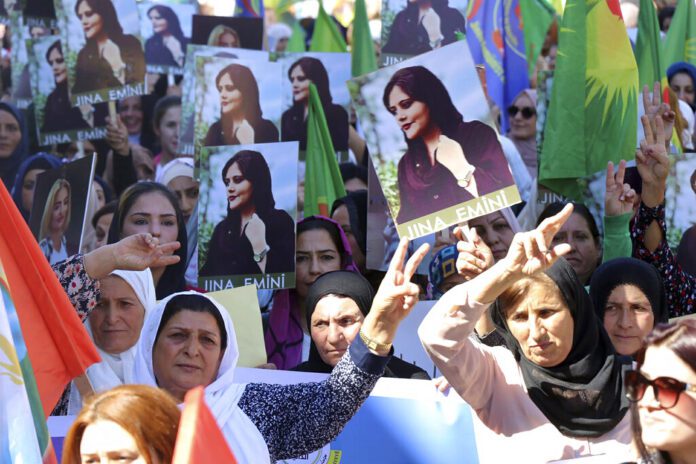Mahsa Amini, 22, died in police custody as a result of police brutality. Arrested by the morality police for not wearing the hijab according to government regulations. Mahsa’s death sparked widespread outrage among Iranian women on social media, and the large-scale protests drew international attention. The US Treasury Department put sanctions on the morality police, yet despite these sanctions and international condemnation, violence against women in Iran persists.
Various cities across Iran are witnessing unrest following the death of Mahsa Amini while in police custody. The 22-year-old from Saqqez, Kurdistan was on a family trip to Tehran when she was arrested by Gasht – e – Ershad, the guidance patrol or more commonly known as the ‘morality police.’ They are in charge with ensuring that Islamic values are upheld, as well as detaining people perceived to be wearing “immodest clothing.”
According to eyewitnesses, she was taken into the police van where she beaten with a baton, her head banged against the vehicle. She died in police custody on 16th of September. Iranian authorities have said that Amini was wearing immodest clothing, but Amini’s family have rejected this. They said she always wore a long coat.
The police blamed Mahsa’s death on pre-existing health conditions, which here family strongly denied. Mahsa’s death in police custody has evoked a strong reaction among Iranians, with people taking to the streets in several cities, including the capital, Tehran. Women are at the forefront, without fear of consequences, their pain and anger no longer containable.
Access to social media platforms such as Instagram and WhatsApp have been restricted in a move to block news about protests and unrest getting out. Network data from Netblocks, a global internet monitor working at the intersection of digital rights, cybersecurity and internet governance, confirmed a near total disruption to internet services in parts of Kurdistan Province in West Iran from the 19th of September.
But the rest of the world is closely watching. It is watching the outrage over a young woman’s killing. It is also witnessing frustration over suppression carried out by the state. The last time Iran saw such a strong reaction from its people was during the 2019 fuel protests. Even at that time, the internet was blackout.
It has been reported that arrests have been made and some protestors killed. But despite intimidation tactics by authorities, Iranians are not backing down. The protests coincide with President Ebrahim Raisi’s visit to New York for the United Nation’s general assembly session. The president has come under immense criticism for his UN speech, where he spoke of injustice and human rights violations carried out by other countries.
Iranian authorities use heavy handed tactics to enforce stringent rules and policies. And with restricted freedoms, this has created a stifling environment. But it has been particularly suffocating for women, especially after the Islamic revolution in 1979, when Iran’s mandatory modest dress rules were imposed.
President Raisi was scheduled to be interviewed by CNN in New York, but it was cancelled by the news channel after he asked journalist Christiane Amanpour to wear a headscarf. Amanpour later tweeted a picture of her sitting opposite an empty chair, without a head covering. It may be that the president wanted to send a message back home. But it was totally unnecessary and backfired.
There is a show of support from people all over the world. But while many are highlighting the situation in good faith, there are also those that are using the situation to push their own agenda. Racists and Islamophobes such as Dutch politician Geert Wilders are cashing in on what is going on right now because it fits their racist, provocative narrative. Even Indian channels that failed to highlight discrimination towards Muslim women in their country are now discussing “women’s rights” in Iran. The same news channels and journalists have been awfully silent on the right of Indian Muslims choosing to wear the hijab. The double standards could not be any more obvious.
And those in particular in the west need to understand that one can call out the Iranian regime and hold it accountable for its actions without having to be racist and without the Islamophobic undertones. Women have the right to make a choice whether or not she chooses to cover her head, and this is the real issue here. A woman’s right to exercise her freedom of choice. Just like women protested in France and India for the right to wear the hijab, women in Iran are protesting for the right to not wear it.
It is too early to say where these protests will lead to. But for now, all eyes are on Iran, as things unfold. US Secretary of State Antony Blinken has already announced sanctions on Iran’s ‘morality police,’ and designated seven other Iranian security officials responsible for supressing non-violent protests. Iran is already reeling from economic sanctions, but it has not had an impact on how the regime operates.
The UN has also demanded an inquiry into Mahsa’s death. But an open and transparent investigation into what really happened is doubtful, and justice for Amini’s family seems unlikely. The family believe authorities are lying but police say there is no evidence of mistreatment. There are, however, serious question marks over what happened and from what we know, this is a very disturbing case. Sadly, this will unlikely be the last tragedy in a state that is unkind to its female citizens.




